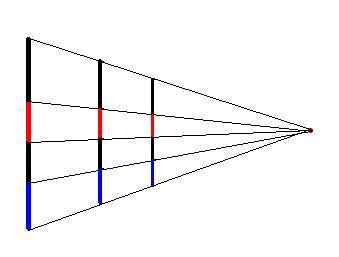The next question that arose, naturally, was how to translate this process into another dimension. Several things must be considered. For any given dimension, vision will operate in D-1 dimensions. There will be a direction perpendicular to these dimensions which is the "extra" dimension along which distortion can occur without it being perceived. However, because of perspective, distortion will also have to occur across the visible dimensions, but this is not arbitrary. This means that visually it remains unchanged in these dimensions, but physically, it will change in accordance to the lines of vision.
Analogies:
2 Dimensions: The object viewed would be a line or a point at all
times. The lines of vision, of which there would be one for each identifying
point on the object, lie flat in the plain. Each point may be moved at
will along these lines of vision without the observer noticing. There
are of course limitations to this distortion as over greater distances
and angles there are more additional factors such as fading of light or
the like.
To us, it would look like this:

However, someone existing in two dimensions only will see the image below, regardless of which of the distortions is presented.

4 Dimensions: The object viewed would be a four-dimensional object. The field of vision would be three-dimensional, which would mean that a complete solid is always viewed, that is, seen from all angles at once. This image would remain the same regardless of distortion in the direction of the fourth dimension away from the viewer. It is not just the projection of the solid which remains the same, but rather the whole thing. It does not change shape or size as long as the rules are followed.